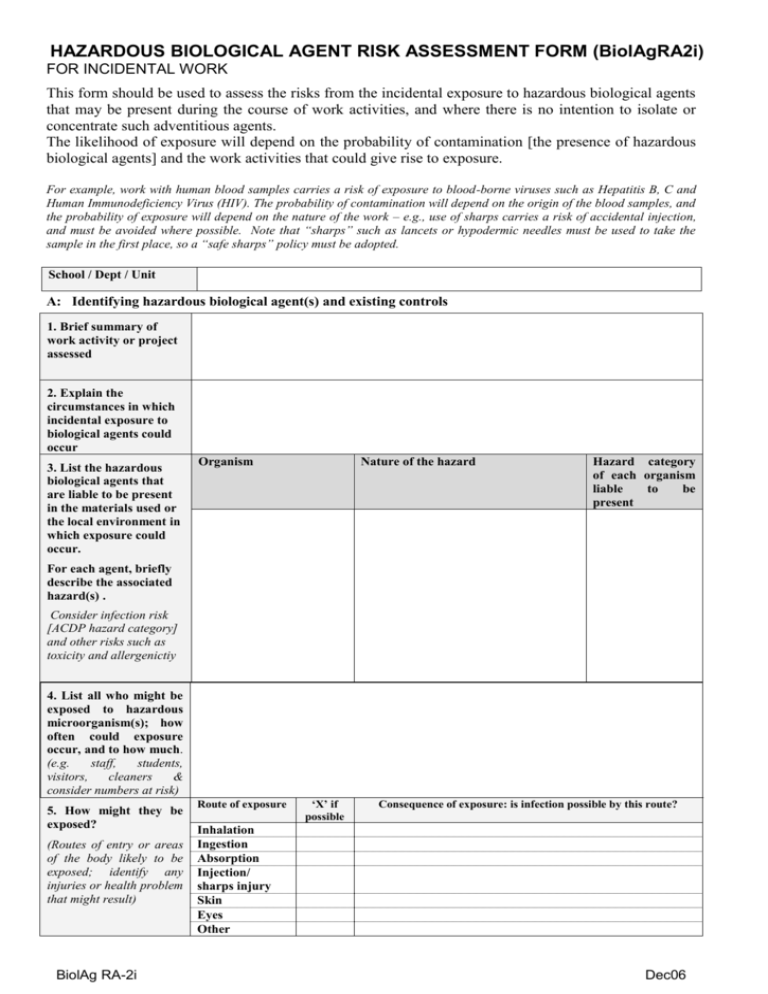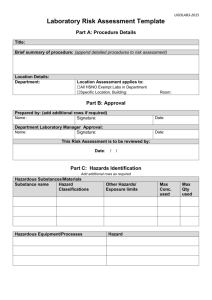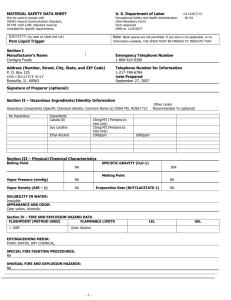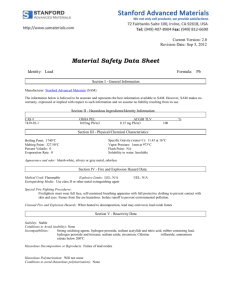HAZARDOUS Biological agent RISK ASSESSMENT FORM
advertisement

HAZARDOUS BIOLOGICAL AGENT RISK ASSESSMENT FORM (BiolAgRA2i) FOR INCIDENTAL WORK This form should be used to assess the risks from the incidental exposure to hazardous biological agents that may be present during the course of work activities, and where there is no intention to isolate or concentrate such adventitious agents. The likelihood of exposure will depend on the probability of contamination [the presence of hazardous biological agents] and the work activities that could give rise to exposure. For example, work with human blood samples carries a risk of exposure to blood-borne viruses such as Hepatitis B, C and Human Immunodeficiency Virus (HIV). The probability of contamination will depend on the origin of the blood samples, and the probability of exposure will depend on the nature of the work – e.g., use of sharps carries a risk of accidental injection, and must be avoided where possible. Note that “sharps” such as lancets or hypodermic needles must be used to take the sample in the first place, so a “safe sharps” policy must be adopted. School / Dept / Unit A: Identifying hazardous biological agent(s) and existing controls 1. Brief summary of work activity or project assessed 2. Explain the circumstances in which incidental exposure to biological agents could occur 3. List the hazardous biological agents that are liable to be present in the materials used or the local environment in which exposure could occur. Organism Nature of the hazard Hazard category of each organism liable to be present For each agent, briefly describe the associated hazard(s) . Consider infection risk [ACDP hazard category] and other risks such as toxicity and allergenictiy 4. List all who might be exposed to hazardous microorganism(s); how often could exposure occur, and to how much. (e.g. staff, students, visitors, cleaners & consider numbers at risk) 5. How might they be exposed? (Routes of entry or areas of the body likely to be exposed; identify any injuries or health problem that might result) BiolAg RA-2i Route of exposure ‘X’ if possible Consequence of exposure: is infection possible by this route? Inhalation Ingestion Absorption Injection/ sharps injury Skin Eyes Other Dec06 HAZARDOUS BIOLOGICAL AGENT RISK ASSESSMENT FORM (BiolAgRA2i) FOR INCIDENTAL WORK 6. List control measures in place to reduce risks Assess whether these controls are adequate, actually used in practice and regularly checked, where appropriate: Hierarchy: Eliminate the need Engineering controls (if applicable) Gloves (Specify type Microbiological safety cabinet Other ventilation Local exhaust Enclose the process Engineering controls (e.g., LEV) if appropriate Procedural controls including need for specific training PPE ……………….) Safety Glasses/Goggles/ Face Shield Other containment (please (Specify specify)……………………………. type……………………..…….) Not applicable RPE Substitute procedure Minimise quantity of material or duration of possible exposure Personal Protective Equipment: Procedural controls Limitation of Access Limitation of Duration/ exposure of non-involved personnel (Specify Type………………….………) Protective clothing (Specify Type………………….………) Other (Specify Type) ……………...…… Restriction of quantities (state max. volume or quantity of material, if relevant……………………..) Prohibition of sharps? Prophylactic vaccination (if “x”, please specify type of vaccine required:.. ……………...…… Provision of specific training (Give details) …………………………………… …………………………… BiolAg RA-2i Dec06 HAZARDOUS BIOLOGICAL AGENT RISK ASSESSMENT FORM (BiolAgRA2i) FOR INCIDENTAL WORK B: Assessing the level of risk and identifying further action needed 7.1 How severe is any health effect likely to be? [Severity can be equated with ACDP or other hazard category of organisms that may be present] 7.2. How likely is exposure to the organism? Take account of possible exposure during accidental spills, etc. 7.3. Calculate the risk score by multiplying the 2 scores in Q7.1 & 7.2 Tick one box Minor Serious Major (1) (2) (3) Very unlikely Unlikely Possible (1) (2) (3) Low Medium High (13) (46) (89) (S =score given in brackets) Tick one box (P =score given in brackets) Risk Score (S x P) = N.B.: If score is 8 or more, the activity must not go ahead until additional measures to control human / environmental exposure have been installed and the activity has been reassessed. 8. Further action/control measures to be taken to reduce risk to health (Use additional sheets if necessary 9. Is health surveillance required? Action to be taken by whom? Implementation Date Y/ N If “Yes”, specify type: 10. Emergency Procedures (First aid actions, spill action, fire etc - Refer to local rules if in place) 11 (If relevant) What are the inactivation and disposal requirements ? Assessor [Project Proposer] Name (please print) Signature Date: Date for Review Date: (maximum 12 months from date of assessment) BiolAg RA-2i Dec06 HAZARDOUS BIOLOGICAL AGENT RISK ASSESSMENT FORM (BiolAgRA2i) FOR INCIDENTAL WORK Approved by: Area Health & Safety Co-ordinator Signature Date: or: Head of Dept/School/Unit Signature Date: Notes for Users 1 This form should be used to assess the risks of work involving the use of materials which may contain hazardous non-modified [non-GM] biological agents1., or situations in which exposure to such agents may occur, but where there is no intention to work with those agents. 2 When assessing the likelihood of exposure, take into account both the likelihood of exposure, and the likelihood that hazardous biological agents may be present. The former will depend on the techniques to be used and the adoption of good occupational hygiene techniques (including use of containment procedures during laboratory work). The latter will depend on the particular situation, such as the provenance of samples or the local environment where the work is to be undertaken, e.g., the presence of recently-manured land in grounds maintenance or farming activities. 3 Where a prophylactic vaccination is identified as an additional control measure, the Occupational Health Service (University staff) or the Medical Practice (for students) should be consulted about the provision of the vaccine. In such cases, the vaccination(s) should be given in good time to allow the development of protective antibody. Examples of such situations include the provision of tetanus vaccination for all involved with soil, grounds maintenance or farmwork. 4 The Biological Safety Officer (Extension 8887, or e-mail to m.iosson@rdg.ac.uk) should be consulted if in doubt as how to proceed with the completion of this form, or how to undertake the risk assessment. 5 The risk assessment must be reviewed at regular intervals not exceeding 12 months, or earlier if any aspects of the work/ workers change. A biological agent is defined in law as a “micro-organism, cell culture or human endoparasite whether or not genetically modified, which may cause infection, allergy, toxicity or otherwise create a hazard to human health”. For the purposes of this risk assessment, “environmental risks” created by use of Controlled pathogens are also included. 1 BiolAg RA-2i Dec06







